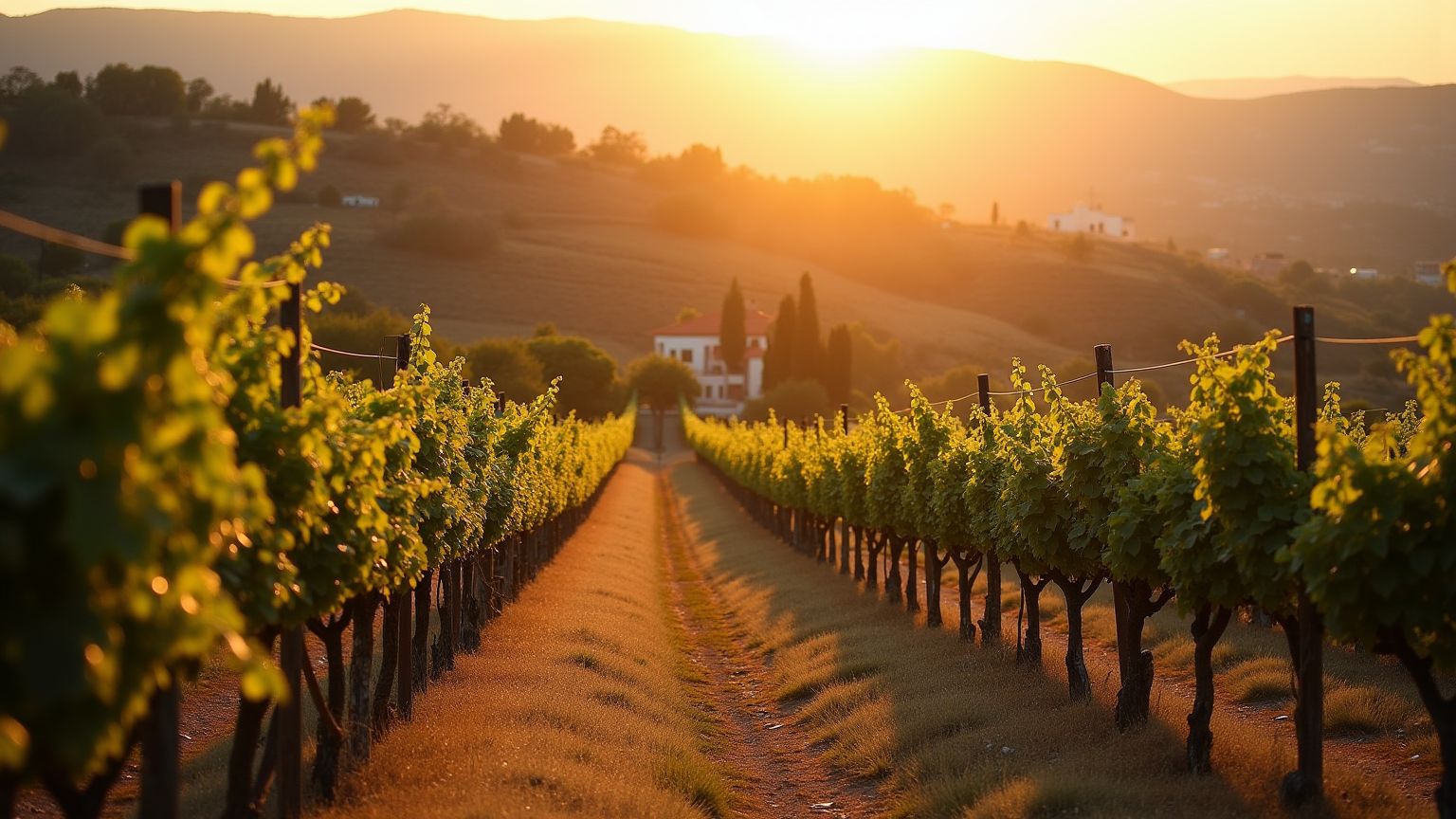A Guide to Nemea Wine’s Lover: Discovering Greece’s Premier Wine Region
Having run my boutique tour company in the Peloponnese for the past decade and a half, I've witnessed countless visitors become utterly smitten with Nemea wine and its ancient viticultural landscape. Growing up just beyond the borders of this renowned wine country, I feel a personal connection to these ruby treasures and can't wait to reveal why Nemea wine deserves your attention.
The Heart of Greek Winemaking: Nemea's Rich Heritage
Tucked into the northeastern pocket of the Peloponnese, roughly 100 clicks southwest of Athens, Nemea wine represents more than just another pretty Mediterranean grape-growing spot—it's the veritable birthplace of Greek red wine traditions with viticultural roots stretching back three millennia.
When guiding visitors through these rolling hills, I love pointing out that even Homer couldn't resist mentioning Nemea wine in his epic tales, dubbing this verdant landscape "Ampeloessa"—literally "drowning in vines." The ancient Greeks weren't prone to exaggeration here; this patch of earth genuinely seems divinely crafted for growing grapes.
The wine of Nemea region sprawls across the undulating terrain surrounding Mount Kyllini, with vineyards perched at dramatically different heights—from 250 meters all the way up to nearly 900 meters above the glittering Mediterranean. This elevation dance creates distinct microclimates that generations of winemakers have cleverly harnessed. Unlike Greece's island wine regions, Nemea wine country enjoys slightly cooler temperatures with just-right rainfall—perfect conditions for its signature grape variety.
The King of Greek Grapes: Agiorgitiko

If Agiorgitiko (ah-yor-YEE-ti-ko) hasn't crossed your lips or your palate yet, you're missing out on Greece's vinous crown jewel. This native Greek variety sits comfortably on the throne of Nemea wine and sometimes gets called "St. George's grape" in English. Local folklore claims it was named after Nemea's Saint George chapel, though every wine producer seems to have their own colorful version of this origin story.
During my rookie years as a guide, I struggled to capture what makes this grape so extraordinary until a weathered winemaker with hands like gnarled vines put it beautifully: "Agiorgitiko is Greece's soul in liquid form—adaptable, tenacious, with hidden complexities that reveal themselves only to the patient."
This chameleon-like grape produces everything from vibrant, fruit-forward Nemea wine to age-worthy bottles with mind-boggling depth. In the lower vineyards, Nemea wine shows off fuller bodies with gentle tannins and generous plum and cherry notes. Climb higher, and the wines transform—becoming more structured with bright acidity and serious aging chops.
After countless wine of Nemea tastings across the region, I can confidently say the finest examples display an alluring ruby brilliance, silky-smooth texture, and that distinctive harmony between fruit, acidity, and subtle spice notes that makes them dance perfectly with traditional Greek dishes.
Nemea's Wine Zones: Understanding the Terroir
Visitors frequently ask me, "Why does each Nemea wine taste so different?" The answer lies in the region's incredible terroir diversity. The official Nemea wine appellation encompasses 16 distinct villages, with vineyards stratified into three altitude-based zones:
1. The Lowland Zone (250-450m)
• Clay-rich, alluvial soils dominate
• Produces approachable, fruit-forward Nemea wine
• Softer tannins and ready-to-drink profiles
• Perfect introduction for Nemea wine newcomers
• Pairs brilliantly with lighter Mediterranean dishes
2. The Mid-Level Zone (450-650m)
• Limestone and clay soils impart distinct minerality
• The sweet spot where Nemea wine truly excels
• Beautiful balance between ripeness and acidity
• 5-7 year aging potential
• Exceptional partner to traditional Greek roasted meats
• Most awarded Nemea wines often come from these elevations
3. The Highland Zone (650-900m)
• Produces the most structured Nemea wine expressions
• Higher acidity and more pronounced tannins
• 10+ year aging potential
• Last autumn, I uncorked a 15-year-old highland Nemea wine that stunned everyone at the table—still vibrant and evolving, with layers unveiling themselves throughout the evening
When to Visit: Seasonal Considerations
Having tramped through Nemea wine country in every season, I've got some battle-tested advice on timing your vinous adventure:
Spring (April-May):
My heart belongs to springtime in Nemea wine country. Tender green shoots emerge from gnarled vines, temperatures hover in that perfect 15-25°C sweet spot, and wild poppies create crimson carpets between vineyard rows. Most wineries haven't yet been swamped by summer crowds.
Summer (June-August):
Tourist high season brings bustling tasting rooms and mercury that frequently pushes beyond 30°C. If summer's your only option for exploring Nemea wine territory, schedule your winery visits before noon when both temperatures and your taste buds are at their freshest.
Autumn (September-October):
Harvest transforms Nemea wine country into a hive of frenzied activity. Many estates offer hands-on harvest experiences—from clipping grape clusters to participating in old-school foot stomping. The annual Nemea Wine Festival in early September transforms the entire region into one gigantic celebration of all things Agiorgitiko.
Winter (November-March):
The sleeper season. Smaller family Nemea wine producers might limit their hours, but larger estates maintain regular operations. The stark beauty of dormant vineyards against winter skies offers moody photography opportunities, and you'll likely have tasting rooms nearly to yourself.
Must-Visit Wineries in Nemea
After sampling more wine than I probably should admit, here are the estates that consistently deliver memorable visits:
Domaine Skouras
Founded by George Skouras, who cut his winemaking teeth in Burgundy, this estate brilliantly marries traditional and cutting-edge approaches. Their Grand Cuvée Nemea wine showcases Agiorgitiko's full potential. The sunlit tasting room offers sweeping vistas of perfectly maintained vineyards.
Worth knowing:
- Opens Monday-Saturday, 10am-4pm (booking ahead saves disappointment)
- €10 tasting fee includes four distinctive Nemea wine expressions
- Tours available in English, Greek, and French
- Their limited "Megas Oenos" bottling sells out annually
Gaia Wines
Housed in a cleverly repurposed industrial structure, Gaia embodies the innovative spirit reshaping Greek wine identity. Their wine experiments with both oak and concrete fermentation vessels, creating fascinating complexity. Staff expertly decode both time-honored and contemporary winemaking approaches.
Worth knowing:
- Welcomes visitors Monday-Friday, 10am-3pm, Saturdays by appointment
- €8 tasting fee (they'll waive it if you purchase)
- Their educational video presentation unpacks Greek wine history without boring you
- Their "Agiorgitiko by Gaia" ages beautifully—buy extra bottles for your cellar
Papaioannou Estate
Perhaps Nemea wine's most historically significant producer, Papaioannou pioneered organic viticulture in Greece. Their old-vine wine bottlings demonstrate world-class potential. Three generations of family expertise inform every aspect of production.
Worth knowing:
- Open daily, 9am-5pm
- €12 tasting includes delicious homemade Greek meze
- Walking tours through their organic vineyards show viticulture without chemical shortcuts
- Their library Nemea wines occasionally appear for special tastings—always say yes!
Semeli Estate
Perched at 600 meters, Semeli offers jaw-dropping panoramas and hospitality that rivals luxury resorts. Their "Asterides" reserve Nemea wine achieves remarkable elegance. For those wanting to immerse themselves completely in wine country, their boutique accommodations hit all the right notes.
Worth knowing:
- Opens daily, 10am-6pm
- €15 tasting includes access to their premium Nemea wine portfolio
- On-site restaurant requires booking ahead (worth it for sunset dining)
- Overnight stays start at €120—their infinity pool overlooking the vineyards justifies the splurge
Lafkiotis Winery
For visitors craving authentic family winery vibes, this smaller Nemea wine producer delivers genuine hospitality. Three generations work shoulder-to-shoulder here, and tastings typically include Yiayia's homemade treats. Their limited-production, single-vineyard Nemea wines demonstrate remarkable character.
Worth knowing:
- Opens Thursday-Sunday, 11am-4pm
- Modest €6 tasting fee
- Call before visiting for English tours (+30 27460 22221)
- Their barrel sample tastings offer fascinating glimpses into wine evolution
Beyond Wine: Complementing Your Nemea Experience
While Nemea wine undoubtedly headlines the region's attractions, other experiences enhance your visit:
Ancient Nemea Archaeological Site
A five-minute drive from most wineries reveals the ancient stadium where the Nemean Games once rivaled the Olympics. The Temple of Zeus and the remarkably preserved stadium with its original athlete tunnel transport you back millennia. I recommend spending at least an hour here to grasp the region's historical significance before diving into wine tastings.
Essentials:
- Open daily 8am-3pm (closed Tuesdays)
- €6 entrance fee
- Audio guides available in multiple languages
- The museum houses artifacts discovered during excavations
Traditional Tavernas
After fifteen years of dedicated "research" at every local eatery, I confidently recommend Taverna Dionysus in Ancient Nemea village. Their slow-roasted lamb perfumed with rosemary and local herbs creates magic when paired with Nemea wine. For upscale dining with vineyard views, Sofis Restaurant at Semeli Estate offers creative Mediterranean dishes that showcase local ingredients.
Hiking Trails
The mountains embracing Nemea wine country offer spectacular walking routes. The trail connecting Asprokampos village to Prophet Elias chapel (roughly 5km) rewards hikers with sweeping panoramas of the entire wine region. I've hiked this path countless times and still discover new perspectives on this ancient landscape.
Planning Your Visit: Practical Tips
Getting There
Nemea lies approximately 90 minutes southwest of Athens by car. For those preferring not to drive, several options exist:
- Renting a car provides maximum flexibility for winery-hopping
- KTEL buses connect Athens to Nemea town (check schedules—they're limited)
- Private drivers for day trips typically charge €150-200 (worth every euro for serious Nemea wine enthusiasts)
- Several tour companies (including my small outfit) offer curated Nemea wine experiences from Athens
Where to Stay
For full immersion in Nemea wine country, I strongly recommend overnight stays. My tried-and-true accommodation picks include:
Semeli Estate Hotel: Luxury option with vines practically touching your window
Alkyon Resort: Seaside property in nearby Vrachati (20-minute drive to wineries)
Guest House Pelopion: Charming family-run B&B in a lovingly restored stone building
Booking Winery Visits
While some Nemea wine estates accept spontaneous visitors, the most meaningful experiences require advance arrangements, especially during peak season. Contact wineries at least 3-4 days ahead or let your accommodation handle the bookings.
Bringing Nemea Wine Home: Buying and Shipping
Visitors inevitably ask, "How can I get these incredible Nemea wines back home?" Most estates offer shipping within the EU, but international policies vary:
- EU destinations: Shipping typically runs €15-25 per six-bottle case of Nemea wine
- Beyond EU borders: More complex due to varying import regulations, though several wineries maintain international distribution networks
- Hand-carrying options: EU travelers face no limits for personal consumption; others should verify their home country's allowances
Insider tip: When discovering a Nemea wine you adore, ask if distributors carry it in your home country. Many producers have established networks in North America, Europe, and increasingly across Asia.
Final Thoughts: What Makes Nemea Wine Special
After fifteen years guiding wine lovers through these ancient hills, I've concluded that what makes Nemea wine truly extraordinary transcends the exceptional liquid in your glass—it's the profound connection between people, land, and an unbroken vinous heritage.
When you visit Nemea wine country, you're not merely tasting fermented grape juice; you're experiencing millennia of cultural history with each sip. The winemakers aren't just producing beverages; they're extending traditions that link them to countless generations before.
Whether you're a serious wine geek or simply enjoy a good glass of red, Nemea wine offers genuine experiences combining history, culture, and world-class viticulture. The region remains refreshingly untouched by mass tourism, providing authentic encounters increasingly rare in our homogenized world.
I hope this guide inspires your journey to Nemea wine country. Should you have questions about planning your visit, please reach out—nothing brings me more joy than helping fellow wine lovers discover this magical corner of Greece!








